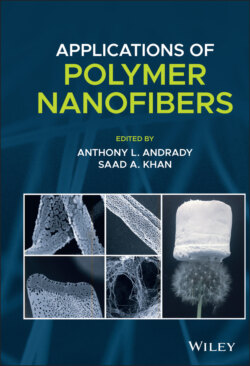Читать книгу Applications of Polymer Nanofibers - Группа авторов - Страница 19
1.4.2 Solvent Selection
ОглавлениеSolvent selection is also an important consideration. Currently, solvent selection is based on trial and error. Further, the solvent characteristics cannot be independently varied to tune desired fiber properties. The key properties of commonly used electrospinning solvents are provided in Table 1.1. Practically, solvent volatility affecting evaporation rate is an important consideration. If solvent remains when the fiber is deposited, the wet fibers can fuse together or result in a ribbon‐like fiber. To avoid such issues, more volatile solvents can be used. However, highly volatile solvents can result in needle clogging. Further, the average fiber diameter of polystyrene fibers has been observed to be inversely proportional to solvent boiling point. Fibers between ~5 and 0.2 μm were achieved by varying the boiling point of the solvent (Wannatong et al. 2004).
In addition to the rate of evaporation, the solvent affects the conformation of the dissolved polymer chains as well as the solution conductivity, surface tension, and viscosity. Generally, good solvents that yield open conformations of polymer chains (to promote entanglement) and sufficient polymer solubility to achieve high solids contents are preferred for electrospinning (Andrady 2008). Luo and coworkers considered 49 solvents for electrospinning polycaprolactone. Solubility alone is not sufficient for electrospinning. They note that solvents with partial (Luo et al. 2010; Shenoy et al. 2005) to high solubility with moderate dispersion forces tended to form uniform fibers. Solvents with strong van der Waals forces/hydrogen bonding and weak polar force formed large droplets (micron to millimeter). Solvents with high molecular weight, low dielectric constant, low boiling point, and/or strong dispersion forces could not be used for electrospinning (Luo et al. 2012).
Table 1.1 Key solvent properties for common electrospinning solvents.
| Solvent | Tb (°C) | Dielectric constant | Surface tension (mN/m) |
|---|---|---|---|
| Acetone | 56 | 20.7 | 23.5 |
| Chloroform | 62 | 4.8 | 26.7 |
| Tetrahydrofuran | 66 | 7.6 | 24.0 |
| Water | 100 | 78.5 | 72.0 |
| Dimethylformamide | 153 | 36.7 | 36.7 |
| Ethanol | 78 | 24.6 | 22.0 |
| Dichloromethane | 40 | 9.1 | 28.1 |
| Formic acid | 101 | 58.5 | 37.7 |
| Acetic acid | 118 | 6.19 | 26.9 |
| Hexafluoroisopropanol (HFIP) | 85 | 16.7 | 16.1 |
Studies of electrospinning polystyrene or PEO from multiple solvents indicate that dipole moment, conductivity, and key solvent properties determine electrospinnability. Supaphol and coworkers considered 18 solvents for electrospinning polystyrene. Qualitatively, they found that solvents with high boiling point and high dipole moment that resulted in polymer solutions with high conductivity, low surface tension, and low viscosity led to fiber formation and minimized needle clogging (Jarusuwannapoom et al. 2005). Using PEO, smaller fibers were observed with solvents with higher dielectric constant (Son et al. 2004) and has been the focus of further investigation.
The dielectric constant of the solvent is critical in electrospinning. Practically, it is how much electrical charge the solvent is capable of holding which affects the surface charge density. Generally, higher dielectric constants are preferred for achieving uniform surface charge density that results in uniform nanofibers. The fiber size is also affected by the dielectric constant of the solvent. For example, an approximate twofold increase in poly(lactic‐co‐glycolic acid) fiber size was observed when the solvent was switched from hexafluoro‐2‐propanol (ε ~ 17) to chloroform (ε ~ 5). A similar trend has been observed in electrospinning polymers from mixtures of solvents to tune the dielectric constant; introducing a solvent with high dielectric constant generally reduces fiber size, for example PCL from mixtures of chloroform ε ~ 5 and DMF (ε ~ 17). An approximate threefold decrease in fiber diameter was achieved by increasing the volume fraction of DMF from 0% to 10%. However, changing solvents affects conductivity, surface tension, polymer chain conformation, and solvent volatility in addition to affecting dielectric constant. Therefore, the observed changes cannot be solely attributed to dielectric constant.
Luo et al. electrospun PCL from formic acid/acetic acid mixtures to systematically vary the dielectric constant at comparable molecular interactions, solubility, boiling point, viscosity, and surface tension (Luo et al. 2012). As the dielectric constant increased, decreased beading was observed and uniform nanofibers where achieved when the dielectric constant was greater than ~19. Notably, the interfiber spacing and mat porosity increased with increasing dielectric constant. The effect on porosity was attributed to increased residual charge at higher dielectric constant. Therefore, the dielectric constant may be an important consideration for tuning the fiber mat porosity.
